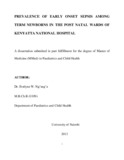| dc.description.abstract | Background: Neonatal sepsis ranks third as a leading cause of infant mortality worldwide. In Kenya it accounts for 60% of the current neonatal mortality rate which stands at 31 deaths per 1000 live births. Despite considerable burden of disease, few data exist on precise incidence and aetiology of early onset neonatal sepsis in sub-Saharan Africa. This study addresses this gap.
Objectives: To determine the proportion of term newborns at risk of neonatal sepsis using two clinical screening tools, prevalence and aetiology of early-onset sepsis in at risk term newborns in the post natal wards of Kenyatta National Hospital (KNH).
Methods: All apparently well term newborns aged 0 – 72 hours old and their mothers at the KNH post natal wards formed the baseline population. Structured questionnaires were administered to consenting mothers in the post natal wards that assessed presence of maternal risk factors and presence of neonatal clinical features suggestive of sepsis. Newborns at risk of sepsis were further evaluated for C-reactive protein (CRP) levels, blood culture and sensitivity and classified as proven (positive blood culture), probable (positive CRP or ≥ 1 clinical feature of sepsis) and no sepsis. Newborns were followed for 72 hours. Those discharged during this time period were followed using telephone interviews. Empirical treatment (Crystalline penicillin and Gentamicin) was started for all babies while awaiting results. Those with probable sepsis continued treatment up to five days depending on clinical assessment on day three and proven sepsis group for seven days. Univariate analysis was used for categorical variables and descriptive statistics for continuous or discrete variables. Bivariate analysis was used to investigate associations between neonatal sepsis and socio demographic variables.
2
Results: Between October 2012 and February 2013, 449 term newborns in the post natal wards were screened for sepsis risk and 139 (31%) found to be at risk. Of the 139 at risk, proven sepsis prevalence was 12% while 58% had probable sepsis. Coagulase negative Staphylococcus (CONS) accounted for 43.5% of isolates. Gram negative bacteria, Escherichia coli, Enterobacter spp. and Proteus spp. accounted for 21% of the isolates.
Conclusion: There is a significant number of well appearing term newborns with sepsis in the post natal wards and as such require routine screening prior to discharge. | en |

